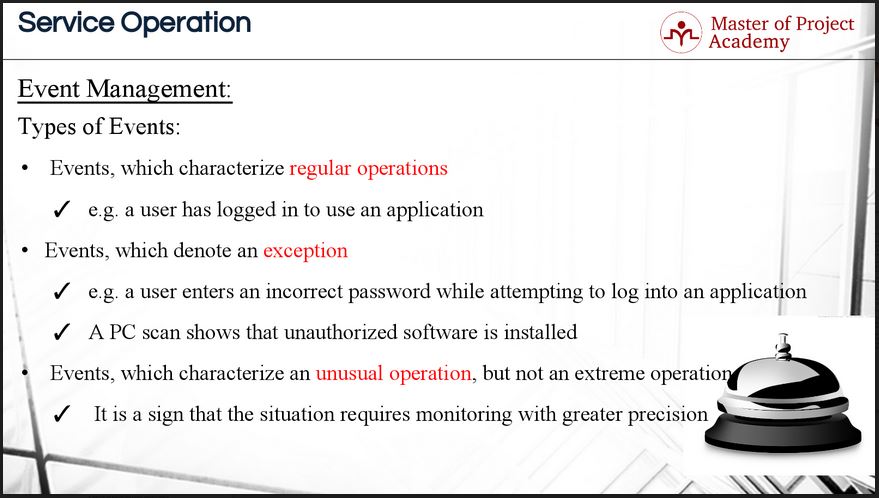The Event Management Process aims to control and manage any events that can occur during the service operation. Briefly, an event is a change or update in the state of any configuration item or IT service. The Event Management Process is an important process used in the ITIL Service Operation stage of the ITIL lifecycle. The ITIL Service Lifecycle, its stages, and processes are briefly discussed in online free ITIL trainings. Furthermore, online ITIL courses explore the objectives and definitions for processes used within the ITIL framework. In this article, we will discuss the goals and objectives, definitions, and types of events that are relevant to the Event Management Process.
- Do you want to learn how to get data analysis in Excel? We are offering you a brand new Excel data analytics course!

The 5 Objectives of the Event Management Process
Identifying and determining corresponding control measures
The first objective for the project manager and the team members is to identify events and determining corresponding control measures. There can be several updates or changes in a service or configuration item. Some of these changes can be critical while some changes can be minor without impacting other aspects of the IT services. The categorization of these events and defining appropriate control measures for these different events is an objective of the Event Management Process.
Programming events in such a way that operational information is transferred
The second objective of the Event Management Process is that events can be programmed in such a way that operational information is transferred. For instance, logging into an application is an event, or starting a service is an event from an IT service management point of view. These actions indicate changes in a configuration item or in a service i.e. they are classified as events. These are all operational information to manage the service operation in an IT Service Provider and the Event Management Process aims to program the flow and management of these kinds of operational information in an IT Service Provider.
Forming the base of many routine activities in operations management
Another objective of the Event Management Process forms the basis of many routine activities of Operation Management. Password change requests every three months are an example of a routine activity for instance. Some companies force employees to change their password every month while some companies force a password change three months etc. Password changes are a routine activity of operation management and these kinds of routine activities are formed by the Event Management Process.
Providing the entry point for many processes and activities of Service Operation
The fourth objective is to provide the entry point for many processes and activities of Service Operation. A problem, an issue, or an indication in ITIL service management is the start point for investigation, monitoring, and analyzing to find an appropriate solution for the event. Therefore, the Event Management Process is the entry point for many processes and activities of service operation.
Providing a basis for service assurance, reporting, and service improvement
The fifth and last objective of the Event Management Process is to provide a basis for service assurance, reporting, and service improvement. IT service providers aim for service improvement to improve the provided services consistently to increase the value provided to the customers. The Event Management Process helps to increase this value delivered to the customers.
- Do you want to improve your business decision-making? Check out our new Financial Forecasting and Modeling Training course!
What is the difference between an alert and an event in the Event Management Process?
Alert and Event are the concepts related to the Event Management Process.
Event Management: Alerts
An alert is a warning that a threshold has been reached, something has changed, or a failure has occurred that is managed in this process. For instance, a disk of a server might have reached its full capacity, an application might have gone down, or a user might have entered his password incorrectly three times causing his account to become locked. These are all examples of alerts.
Alerts are often created and managed by System Management tools and are managed by the Event Management Process. To take immediate action for the alerts, system monitoring tools are used by IT service providers during this process. These tools monitor the IT services and configuration items to check whether there are any alerts. For instance, these tools check whether there is any critical failure in an application or whether there is any exceeded threshold for a pre-determined level. These alerts are monitored by system administrators and proper actions are taken immediately before these turn into further problems in the service delivery.

Event Management: Events
An event is a change of state that has significance for the management of a configuration item or IT service. An event covers any kind of minor and major changes in an IT Service provider and is managed by the Event Management Process. Failure of an application is an event and a wrong password entry of a user is an event as well. The term Event is also used to mean an alert or notification created by any IT Service, configuration item, or monitoring tool in this process. So, an alert is a type of event. Events typically require IT Operations personnel to take action and often lead to incidents being logged. For instance, we have given reaching full capacity in a disk as an example of an alert and locking the account of a user after three incorrect login attempts as an example of an event. Both of these examples require the action of IT Operations personnel to take action. A disk that reached its full capacity must be emptied and the locked user account must be fixed as well.
Types of events in the Event Management Process
There are three types of events that are managed in the Event Management Process. fundamentally: regular operations, exceptions, and unusual operations.
Regular operations
Regular, frequent, and known activities in an IT Service provider are characterized as regular operations. These are managed in this process. For instance, a user login to use an application is characterized as a regular operation. Similarly, a user logging out from the system, using an application in the system, using a service, etc. are all regular operations for an IT service provider.
Exceptions
The second type of event that is managed is an exception. Exceptions refer to an unexpected pattern of activity in an IT Service provider. For instance, if a user enters an incorrect password while attempting to log into an application or if a PC scan shows that unauthorized software is installed, these are examples of exceptions. We expect a user to log on to an application correctly with the correct password or we expect that a PC runs without a virus. Therefore, these are examples of an exception event type.
Unusual Operation
The third and last type of event that is managed in the Event Management Process is an unusual operation. Unusual operations refer to an unexpected situation but not an extreme operations. For instance, while monitoring an application server, it is noticed that there is a high level of CPU usage or the disk of the server fills in too fast. These are examples of unusual operations and the root cause of these unusual operations must be identified to fix to get back into usual and expected operations. Therefore, an unusual operation is a sign that the situation requires monitoring with greater precision.
When a service is operational, the Event Management Process is an important process for keeping on top of any events or alerts which may influence the quality of the service. Therefore, the Event Management Process is key to successful Service Operation.
Review by: Lorraine Morris


One thought on “The 5 Objectives of Event Management Process”
Comments are closed.